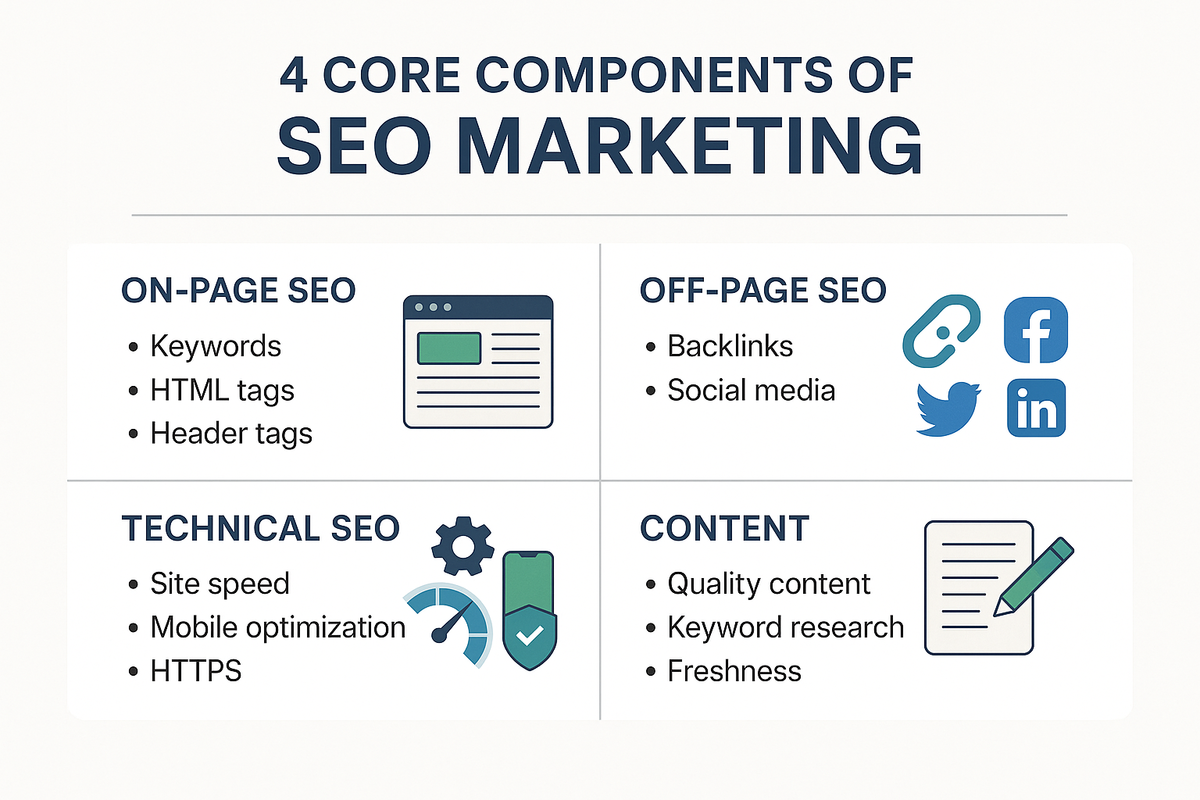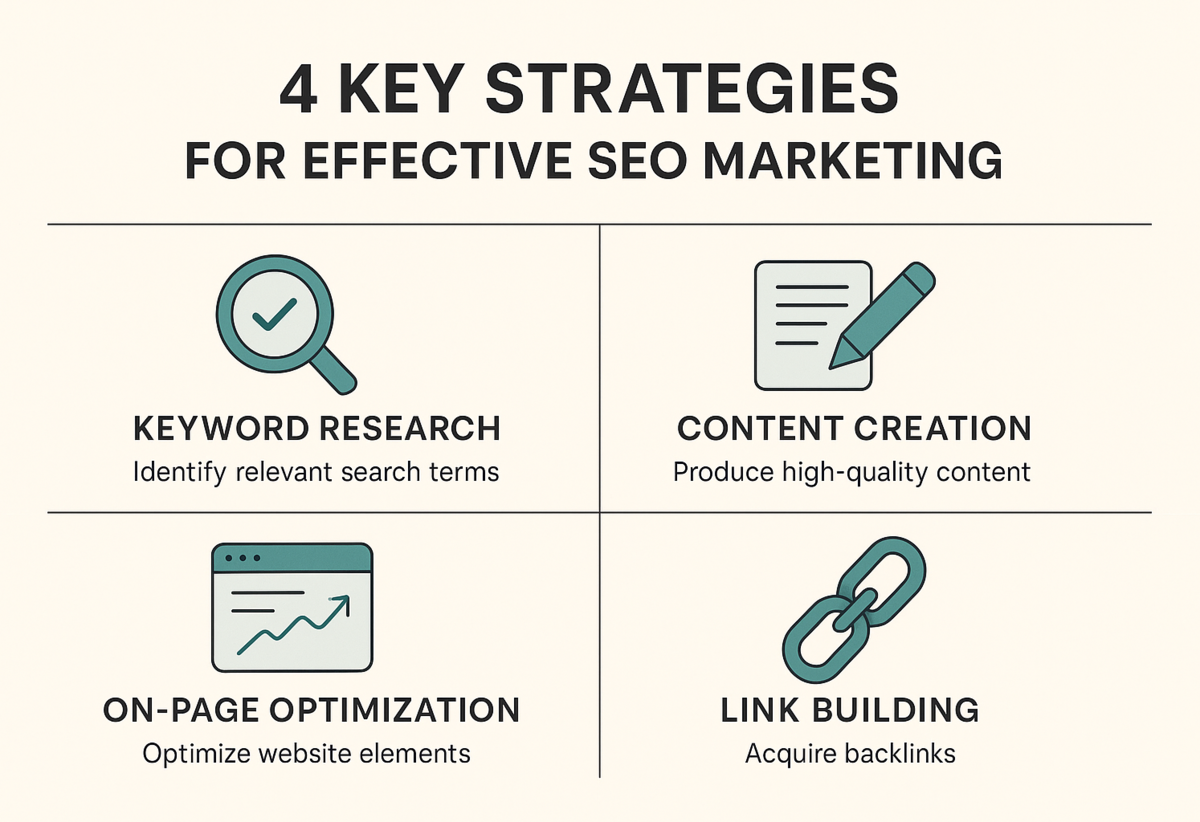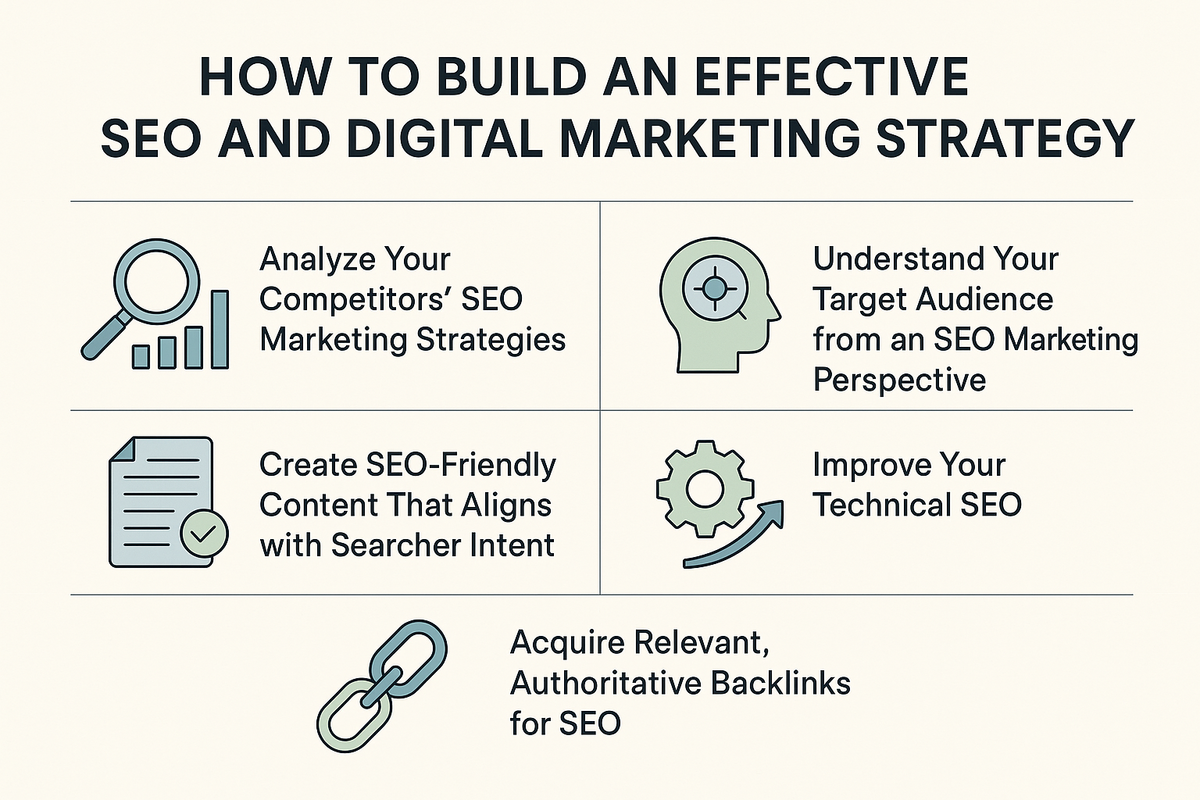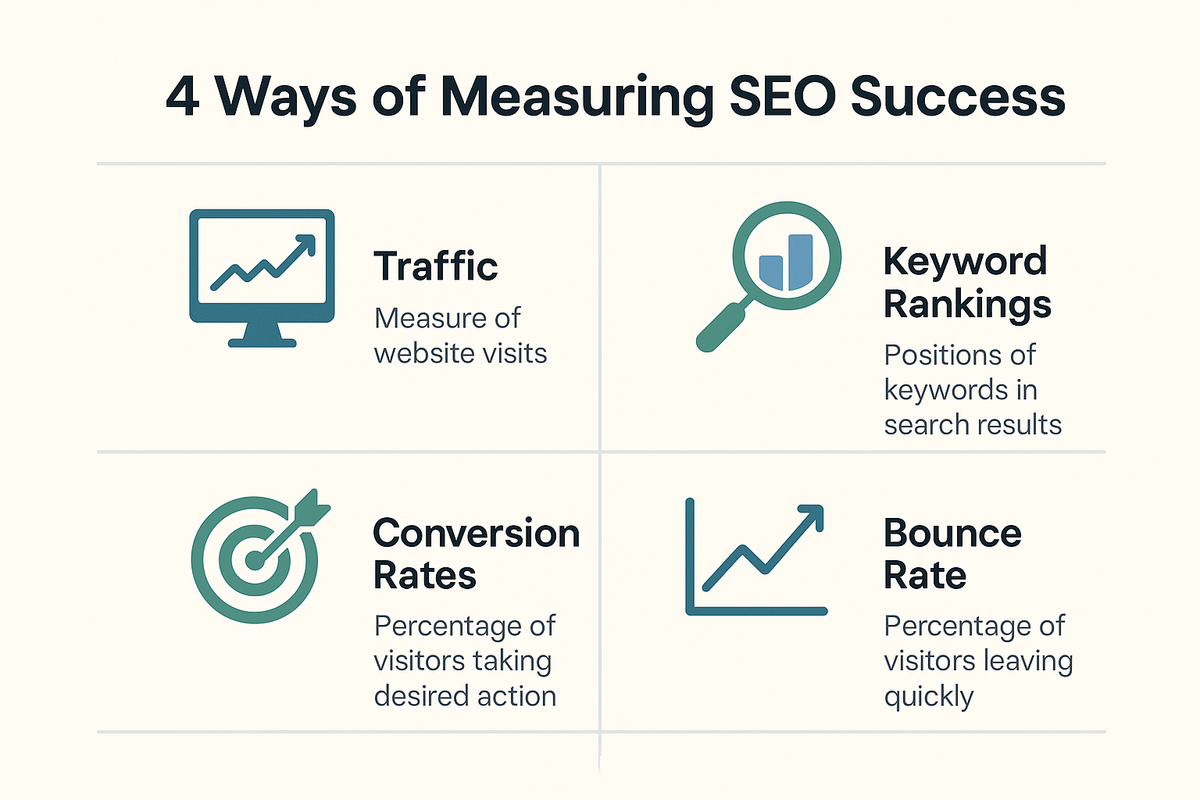SEO Marketing, or Search Engine Optimization Marketing, is a critical component of digital marketing that focuses on improving a website's visibility in search engine results pages (SERPs).
The primary goal of SEO marketing is to attract organic (non-paid) traffic by optimizing various elements of a website, such as content, technical structure, and user experience.
If you’re wondering, what is SEO marketing, it refers to the strategies and practices implemented to increase a website's ranking on search engines, helping businesses get discovered by potential customers.
By implementing effective local or International SEO strategies, businesses can increase their chances of ranking higher for relevant search queries, making it easier for potential customers to find them.
In the digital-first world, a strong online presence is essential for business success.
With millions of websites competing for attention, SEO marketing provides a strategic approach to stand out in search results and connect with an audience actively searching for products, services, or information.
Through long-term, sustained efforts, SEO marketing helps businesses drive consistent and high-quality traffic to their sites, ultimately contributing to increased visibility, higher conversion rates, and sustainable growth.
As competition grows in almost every industry, mastering SEO marketing is key to staying ahead of competitors and reaching your target audience effectively.
What is SEO Marketing?
SEO marketing is the process of optimizing various aspects of a website, including its content, structure, and technical elements, to improve its visibility and ranking in search engine results pages (SERPs).

This involves making sure that the website is easily discoverable by best search engines like Google, Bing, and Yahoo, ensuring that it ranks higher for relevant search queries.
For example, when you search for the best website builders for small business, it’s important for a website to be optimised on this query to appear higher in search results.
What is the Importance of SEO Marketing?
A well-executed SEO strategy is important for businesses aiming to improve their online presence.
By increasing organic traffic, SEO helps drive more visitors to the site without the need for paid advertising. Furthermore, SEO enhances the overall user experience by improving site navigation, load speed, and mobile seo Optimization.
An optimized site not only attracts more visitors but also builds brand credibility by ensuring that it appears in top search results, making it more trustworthy and visible to potential customers.
Why Is Search Engine Marketing Important For Businesses?
As of 2025, Google processes over 8.5 billion searches daily, averaging approximately 13.7 billion searches per day globally.
Mobile SEO is projected to grow at a compound annual growth rate (CAGR) of 10.0% by 2030. For every dollar spent on SEO, businesses earn an average return of $22.
Approximately 58% of online searches are conducted via mobile devices.
Google is projected to account for over 70% of U.S. traditional search ad spending by 2026. Search engines drive 39% of global traffic to E-Commerce Marketing websites.
Who Should Use SEO Marketing?
SEO is not limited to big corporations; any business or individual with an online presence can benefit from ranking higher in search results.
For instance, if you're an eCommerce store use Ecommerce SEO Agency for ranking higher directly influences sales, especially since top search engines drive 39% of global traffic to eCommerce websites.
Here’s who can benefit:
- Businesses: Both local and global brands rely on SEO to increase visibility, attract customers, and stay ahead of competitors.
- eCommerce Stores: With 39% of online shopping traffic originating from search engines, ranking higher directly influences sales.
- Bloggers & Content Creators: SEO drives organic traffic, helps build authority, and opens monetization opportunities.
- Marketing Agencies: Agencies offering global SEO services help their clients implement tailored local or International SEO Strategy for greater visibility and results.
4 Core Components of SEO Marketing
The core components of SEO Audit Checklist include on-page SEO (optimizing web pages with relevant content and
Key elements of technical SEO include improving site speed to enhance load times, as faster sites offer a better user experience and are favored by search engines.
eywords), off-page SEO (building site authority through backlinks and social media engagement), and technical SEO (improving site performance, mobile-friendliness, and security for better crawling and indexing).

1. On-Page SEO
On-page SEO involves optimizing the individual web pages of a website to improve their ranking in search engine results.
This includes ensuring that targeted keywords are strategically placed throughout the page, in the content, headings, and meta tags.
Optimizing HTML tags like title tags, meta descriptions, header tags (H1, H2), and alt tags helps search engines understand the context and relevance of the page.
2. Off-Page SEO
Off-page SEO refers to actions taken outside of the website to improve its authority and reputation.
This is mainly achieved through acquiring high-quality backlinks from reputable and relevant external websites, which signal to search engines that the content is trustworthy and authoritative.
3. Technical SEO
Technical SEO focuses on the backend elements of a website to ensure it is properly indexed by search engines and provides a good user experience.
Key elements of Technical SEO Site Audit include improving site speed to enhance load times, as faster sites offer a better user experience and are favored by search engines.
Explore Our Programmatic SEO Services!
4 Key Strategies for Effective SEO Marketing
Following are the main key strategies for SEO Marketing.

1. Keyword Research
Identifying relevant keywords that potential customers are searching for is crucial for SEO marketing.
Therefore, by understanding the terms and phrases users employ, businesses can tailor their content to meet these search queries, enhancing visibility and attracting targeted traffic.
Tools like Google Keyword Planner and SEMrush can assist in discovering high-volume and low-competition keywords.
2. Content Creation
Developing high-quality, informative, and engaging content that addresses user intent is fundamental.
Content should provide value, answer questions, and solve problems for the audience. Incorporating targeted keywords naturally into well-structured content can improve search engine rankings and user engagement.
3. Link Building:
Acquiring backlinks from authoritative websites to boost domain authority is a key off-page SEO strategy. Quality backlinks signal to search engines that the content is credible and trustworthy.
Methods include guest blogging, influencer collaborations, and creating shareable content. SEO ranking report software can assist in tracking and analyzing the backlinks' effectiveness in boosting site rankings.
4. User Experience (UX) Optimization
Ensuring the website is user-friendly, with intuitive navigation and fast loading times, enhances user satisfaction and retention.
A positive UX Design Strategy reduces bounce rates and encourages visitors to spend more time on the site, which can positively impact search engine rankings.
The table below shows the SEO strategy and its effect on user experience.
| SEO Element | User Experience |
|---|---|
| Optimized site architecture and navigation | Clicking from one page of the site to another with ease. |
| Optimized content on every page | Reading a webpage easily, absorbing authoritative and relevant information, taking actions such as subscribing to emails, filling out a contact form, or making a purchase. |
| Faster load times | Clicking and scrolling faster with minimal delays in viewing information. |
How To Build an Effective SEO and Digital Marketing Strategy?
In this section, you’ll focus on improving your website’s content, domain authority, and technical elements to make your site more discoverable and beneficial for your target audience. The following steps will guide you on how to enhance your SEO marketing efforts to reach your audience effectively.

1. Analyze Your Competitors' SEO Marketing Strategies
Just like any marketing strategy, analyzing your competitors is key to improving your SEO performance. By understanding how your competitors approach SEO in digital marketing, you can identify gaps and opportunities to optimize your content and website.
- Make a list of competitors who rank highly for keywords related to your services and products. This includes both well-known competitors and those who rank at the top of SERPs (Search Engine Results Pages).
- Audit competitors’ websites for their SEO and content marketing strategies. Examine their content quality, website navigation, and user experience (e.g., how easily users can find information or take action).
- SEO Tools For Small Businesses or large-scale Businesses used Semrush, Ahrefs, or Moz to discover the specific SEO online marketing keywords your competitors are targeting and analyze their ranking positions.
- Inspect their meta tags by right-clicking on their site and selecting “View Page Source” to gain insights into their SEO strategies.
2. Understand Your Target Audience from an SEO Marketing Perspective
Understanding your audience's search behavior is crucial in optimizing your SEO strategy. Knowing what they search for and why helps you create content that addresses their needs effectively.
- Use SEO tools like MozBar or Keyword Surfer to research relevant keywords directly from your browser while browsing search engine results pages (SERPs).
- Leverage Best SEO Reporting Software such as Semrush to analyze searcher intent for specific keywords, such as informational, navigational, transactional, or commercial.
- Investigate the questions people ask in search queries, the related searches, and featured snippets, which can help you craft content that aligns with user intent.
3. Create SEO-Friendly Content That Aligns with Searcher Intent
Creating valuable and SEO-friendly content is an ongoing effort that helps your audience find relevant, authoritative information.
- Ensure that the content on your website, whether it’s a blog post, sales page, or landing page, is original and satisfies the SEO marketing needs of your audience.
- Integrate relevant keywords naturally into your content without overusing them. Focus on providing value, clarity, and answering common user queries related to SEO internet marketing.
- Structure your content with clear subheadings, bullet points, and numbered lists for easy reading and better search engine optimization.
- Enhance your content with multimedia elements, such as relevant images, infographics, and videos, to improve user engagement.
- Make your content actionable by including compelling calls-to-action (CTAs) to encourage users to engage with your services, whether it’s subscribing, filling out a form, or making a purchase. Explore what is cta in marketing
4. Improve Your Technical SEO
To stay competitive in SEO online marketing, it's essential to optimize your website's technical structure, which directly influences how search engines crawl and rank your site.
- For individual pages, ensure your SEO advertising includes optimized title tags (50-60 characters) and meta descriptions (up to 160 characters) that clearly communicate the page’s content and include the target keyword.
- Compress images to ensure faster loading times, which is critical for SEO. For example, reduce large images to improve site speed and performance.
- Use descriptive, keyword-rich file names for images, such as "Oil, Gas and Renewables.jpg," instead of generic names like "image1.jpg."
- On a site-wide level, implement clear navigation menus to improve user experience and facilitate easy site exploration. This boosts both user satisfaction and search engine rankings.
- Create and submit an XML sitemap to Google Search Console to improve crawlability and indexing for better visibility in search results.
5. Acquire Relevant, Authoritative Backlinks for SEO
Backlinks are an important factor in digital marketing SEO, as they indicate to search engines that other reputable sites trust your content.
- Create an seo strategy to obtain SEO company services and relevant backlinks from authoritative websites within your industry. Reach out to these sites to request backlinks, offering to provide content or guest blog posts in exchange.
- Use social media and email marketing to promote your content and increase the chances of others linking back to it. Sharing your pages on social platforms and in newsletters can attract more backlinks.
- A strong backlink profile signals credibility to search engines, which improves your site's SEO in Digital Transformation and can help boost your rankings.
By following these steps and continuously optimizing your website's SEO, you can enhance your visibility in search engines, attract more traffic, and ultimately drive better results for your business. This holistic approach ensures that your website SEO marketing aligns with both user intent and search engine algorithms.
4 Ways of Measuring SEO Success
Measuring SEO success involves analyzing key performance indicators (KPIs) to evaluate the effectiveness of your optimization efforts.

By tracking these metrics, you can identify areas for improvement and adjust your strategies accordingly.
1. Traffic Analysis
Monitoring the volume and quality of organic traffic helps determine how well your content attracts visitors from search engines.
Tools like Google Search Console and Google Analytics provide insights into user behavior and traffic sources.
2. Keyword Rankings
Tracking the positions of targeted keywords in search results allows you to assess the effectiveness of your SEO efforts and identify opportunities for optimization.
Regular monitoring can help you stay competitive in search rankings.
3. Conversion Rates
Assessing how well your website converts visitors into customers or leads is crucial for measuring ROI.
By analyzing conversion paths and user interactions, you can optimize your site to improve conversion rates. Explore What is CRO & What is a Conversion Funnel
4. Bounce Rates
Evaluating the percentage of visitors who leave the site after viewing only one page helps identify issues with user engagement.
A high bounce rate may indicate the need for improved content or user experience.
How to Analyze SEO Data & Improve Performance?
Collecting SEO data is just the beginning. To maximize its potential, you need to analyze the data and take action based on your findings. Here's how to interpret SEO data and optimize your efforts to improve performance:
1. Organic Traffic is Low
If your organic traffic is lower than expected, this often signals that your SEO marketing strategy needs adjustment. Start by revisiting your keyword selection. Identify and optimize underperforming pages by enriching their content with valuable, high-quality information that aligns with user intent. Include more targeted terms like SEO digital marketing or digital marketing SEO Company to broaden your reach.
Additionally, improving internal linking can make your site more navigable, helping search engines crawl and index your content better, while guiding users seamlessly through your website. This practice is essential in online marketing SEO services.
2. Rankings Fluctuate
Search engine rankings can vary due to algorithm updates or shifts in user behavior. If you notice fluctuating rankings, check tools like Google Trends or Semrush to understand the changing landscape of SEO internet marketing. It’s crucial to revisit your content regularly to ensure it’s relevant and authoritative, especially when targeting what is SEO marketing or SEO company services.
Make sure that your articles, blogs, and service pages are always up to date, reflecting current trends and searcher expectations.
3. Low Click-Through Rate (CTR)
A low CTR might indicate that your title tags and meta descriptions are not compelling enough. You need to optimize them to attract more clicks. For instance, create meta descriptions that incorporate the right keywords like SEO advertising or online marketing SEO services. Be sure they clearly communicate the value your page offers while being concise and action-oriented.
Additionally, adding numbers, questions, or power words in your titles can boost clickability, making your page more appealing to users searching for SEO in digital marketing.
4. High Bounce Rate
A high bounce rate indicates that users are leaving your site quickly without engaging. This may be due to poor user experience or irrelevant content. To address this, break down your content into easily digestible sections, use subheadings, bullet points, and visuals to keep visitors engaged. Also, improve page load speed by optimizing images and reducing unnecessary scripts. A faster, more engaging site will encourage visitors to stay longer and explore more pages.
Incorporate rich media like videos and infographics, especially when promoting SEO and content marketing, to make your pages more interactive and appealing to users.
5. Important Pages Aren’t Being Indexed
If certain key pages aren’t appearing in search results, there might be a technical issue preventing them from being crawled by search engines. To address this, start by checking for crawl errors in Google Search Console. Ensure that no important pages are blocked by robots.txt and that your server is functioning smoothly.
Revisit your internal linking strategy to ensure that search engines can easily find and index crucial pages, especially those tied to website SEO marketing or internet marketing SEO.
Additionally, submitting an updated sitemap to Google Search Console can help ensure that search engines crawl and index missing pages more effectively.
Pro Tip: Stay Ahead of SEO Trends
To keep up with the constantly evolving world of SEO, it's crucial to regularly audit your site and align your strategies with the latest trends. For example, test out new SEO strategies such as experimenting with different content formats, adjusting keyword targeting, or optimizing technical aspects of your website to remain competitive in the SEO marketing space.
Continuous SEO Analysis
The key to ongoing success in SEO marketing is continuous analysis and adaptation. Track historical data to spot trends and adjust your SEO efforts accordingly. By maintaining a regular SEO audit schedule, you’ll stay ahead of potential algorithm updates and avoid performance dips.
Incorporating the best practices from the world of SEO digital marketing will allow you to improve your rankings, increase organic traffic, and enhance your SEO advertising efforts. Over time, this will turn SEO into a long-term, sustainable asset for your business.
Explore Our Performance Marketing Services!
Future Trends in SEO Marketing
As we move into 2025, SEO marketing is undergoing significant transformations driven by advancements in technology and shifts in user behavior.
Key trends shaping the future of SEO include:
1. Voice Search Optimization
With the increasing use of voice-activated devices optimizing content for voice search is becoming essential.
This involves focusing on natural language processing and conversational keywords to align with how users speak rather than type.
2. Mobile-First Indexing
Search engines are prioritizing mobile-friendly websites in their rankings.
Ensuring that your website is responsive and provides a seamless experience across all devices is crucial for maintaining visibility in search results.
3. AI and Machine Learning
Artificial intelligence is revolutionizing SEO by enabling more personalized search experiences and predictive analytics.
Machine learning algorithms help in understanding user intent and delivering more relevant content, thereby enhancing user engagement and satisfaction.
FAQs: What Is SEO Marketing?
What is SEO Marketing?
SEO marketing is the process of optimizing a website’s content, structure, and technical aspects to improve its visibility on search engine results pages (SERPs). This includes strategies to attract organic (non-paid) traffic, ensuring that your website ranks higher for relevant search queries. By implementing SEO strategies, businesses can enhance their digital marketing SEO efforts and reach their target audience more effectively.
What Does SEO Stand for in Marketing?
SEO stands for Search Engine Optimization in marketing. It refers to the practice of optimizing a website’s content and structure to improve its ranking on top search engines like Google. This helps businesses increase their organic search traffic, making it easier for potential customers to find them through relevant search queries.
How Does SEO Marketing Benefit Businesses?
SEO marketing plays a pivotal role in driving organic traffic to websites. It increases visibility, builds brand credibility, and helps businesses stand out in competitive markets. By optimizing for SEO in digital marketing, businesses can generate consistent, high-quality traffic, leading to better conversion rates and long-term growth.
What is the Role of SEO in Digital Marketing?
SEO in digital marketing is crucial for enhancing a website’s online presence. It helps ensure that a website appears on the first page of search engine results for relevant queries, which is vital for gaining visibility. With the right SEO digital marketing strategies, businesses can optimize their content and technical structure to achieve higher rankings and attract more customers.
How Do SEO Company Services Help Improve Website Rankings?
Professional SEO company services are designed to optimize your website for search engines, improving its ranking in SERPs. These services typically include keyword research, on-page and off-page SEO, SEO advertising, and improving site performance. With expert guidance, businesses can develop a tailored SEO strategy that aligns with their goals and targets specific keywords to drive traffic.
What is the Difference Between SEO and Online Marketing SEO Services?
While SEO focuses on improving a website’s organic rankings through various strategies like content optimization, technical SEO, and link building, online marketing SEO services encompass a broader range of strategies aimed at driving traffic to your website. These services often include paid advertising, content marketing, and SEO combined with other digital marketing efforts to boost a business’s online visibility. By leveraging internet marketing SEO, businesses can ensure they stay competitive across multiple channels.
Conclusion: Navigating the Future of SEO Marketing
As we advance into 2025, SEO marketing is undergoing a profound transformation driven by technological innovations and shifting user behaviors. Traditional SEO practices are evolving to accommodate new paradigms such as voice search optimization, mobile-first indexing, and the integration of artificial intelligence (AI) and machine learning. If you're asking what is SEO marketing, it now involves optimizing for these new technologies, as businesses must focus on enhancing user experience and content strategies to stay relevant in this rapidly changing landscape. These changes necessitate a strategic shift towards optimizing content for AI-driven search engines and enhancing user experience across all devices
To remain competitive, businesses must adapt to these emerging trends by embracing AI technologies, optimizing for voice search, and ensuring mobile-friendly website designs. Additionally, focusing on user intent and providing high-quality, relevant content will be crucial in maintaining visibility and engagement in an increasingly AI-centric digital landscape. For businesses looking to scale their digital marketing efforts, partnering with a digital marketing agency like Centric that specializes in enterprise SEO and digital marketing services can provide a comprehensive strategy to stay ahead of the competition.









